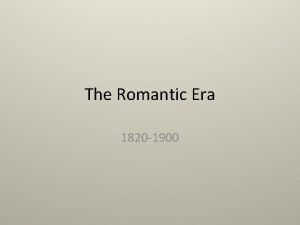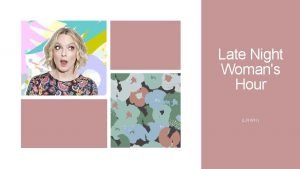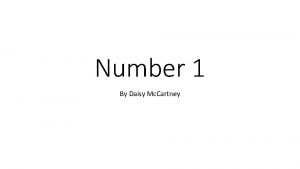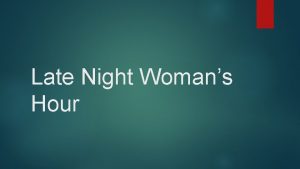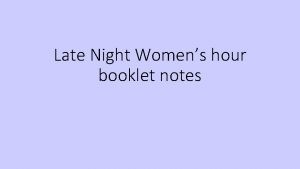LNWH Daisy Mc Cartney PRODUCT CONTEXT Late Night







- Slides: 7

LNWH Daisy Mc. Cartney

PRODUCT CONTEXT • • Late Night Woman’s Hour is a spin-off from the long-running BBC Radio 4 daily magazine programme, Woman’s Hour. • • Late Night Woman’s Hour is broadcast once a month, late at night, is presented by Lauren Laverne and features a number of female panellists. • • Each episode focuses on a particular theme relevant to its female audience e. g. ‘home’ and ‘forgiveness’. • • It began broadcasting in 2015

MEDIA INDUSTRIES HISTORICAL CONTEXTS • The original Woman’s Hour first broadcast in the 1940 s – this could be seen as, a minority audience programme • one hour a day or week set aside just for a female audience. • suggest a strong sense of patriarchal control, both on the BBC and in UK society at the time • Late Night Women’s Hour features frank and open discussion and demonstrates a shift in society and increased gender equality although some of the issues raised reflect the fact that society is not yet completely equal. INSTITUTION AND ECONOMIES • The BBC raises its finances from the license fee currently at £ 147 per year – and is paid by the UK population in order to consume TV and radio broadcasts, whether they are BBC products or not. • Since 1922 the BBC has been committed to its mission to inform, educate and entertain • It could be argued that commercial broadcasters (those who are set up to make a financial profit through advertising) might see a programme like LNWH as being too specialised, aimed at a relatively small audience and broadcast at an unpopular time. • The BBC, however, have a commitment to producing a wide selection of content, aimed at all sections of the population. In which case, LNWH could be seen as a ‘typical’ BBC product

SCHEDULING • Late Night Woman’s Hour has an 11 p. m. broadcast timeslot. However, audiences can now listen on digital devices other than radios and download podcasts to enjoy at their leisure which means the time a broadcast airs live might be less significant. • Digital technology, such as Digital Audio Broadcasting (DAB), possibly offers broadcasters like the BBC more freedom to produce challenging content which would normally got out after the 21. 00 watershed (the time which more ‘adult’ themes can be shown on TV and radio, such as violence or language), and still be heard at any given time though downloadable content.

AUDIENCES • The audience for Radio 4 generally can be categorised in terms of age, social class and expected levels of education. This referred to as Demographics. • A stereotypical Radio 4 listener is likely to be educated often to degree level, be in a managerial/senior/educational job environment, upper-middle class, aware of current affairs – and most likely male • Lauren Laverne should be considered in view of her background – she was once a member of an indie-rock band, Kenickie, in the 1990 s. This would make her an untypical ‘Radio 4 -type; presenter. Audience targeting for Late Night Woman’s Hour • Highlights the nature of PSB and the BBC’s mission of inform, educate and entertain. Designed to explicitly appeal to a specialised (educated, female) audience, with potentially a younger age group than usual for Radio 4. This might be due to the content of the programmes and the makeup of the guests. • Is its apparent success down to its uniqueness, as this is the only programme of its type on radio? ITVs Loose Women could be somewhat compared for television, but the target audience is perhaps not so ‘educated’? • The programme may also be targeting a younger audience (late teens to early thirties) with the variety of subjects featured in the series

THEORETICAL APPROACHES Stuart Hall’s Reception Theory • Consider how a negotiated or oppositional reading of the programme might be used. How would a male audience respond to an all-female broadcast, debating issues from an entirely-female perspective? Feminist Theory • A broad term which could also cover aspects of society and culture. • Radio for women about women by women • The series provides women with a vehicle through which to discuss and construct representations of gender • The set product programme – ‘Home’ – sets up a diverse and challenging discussion on the subject and the changing place of women within that environment

KEY MEDIA TERMS REFERENCED • AUDIENCE – target, global, positioning, categorising, profile Reception Analysis • PUBLIC SERVICE BROADCASTING • COMMERCIAL BROADCASTING • THE BBC’S MISSION – inform, educate, and entertain • NICHE MARKET • DIGITAL CONVERGENT PLATFORMS • IDEOLOGY – linked to representation and of the BBC • SOCIAL MEDIA PLATFORMS • DEMOGRAPHICS – link to Audience • PSYCHOGRAPHICS – link to Audience

